The ecology of Hong Kong is mostly affected by the results of climatic changes. Hong Kong's climate is seasonal due to alternating wind direction between winter and summer.

Phlyctimantis maculatus is a species of frog in the family Hyperoliidae. They are silvery greyish-brown with dark brown to black spots, and derive their name from bright red coloring on the ventral side of their hind legs. Adult body length is typically 6 to 7.5 centimeters. These frogs have vertical pupils. Common names include red-legged running frog, brown-spotted tree frog, red-legged Kassina, red-legged pan frog, spotted running frog, tiger leg running frog, and vlei frog.
Mahatha is a genus of freshwater crabs endemic to Sri Lanka. Four of the six species are critically endangered due to habitat loss, and two are listed as Least Concern on the IUCN Red List.

Minuca pugnax, commonly known as the Atlantic marsh fiddler crab, is a species of fiddler crab that lives on north-western shores of the Atlantic Ocean.
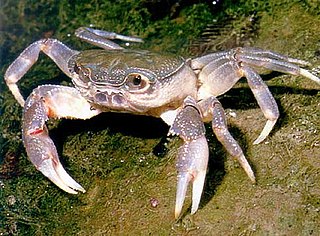
Potamon fluviatile is a freshwater crab found in or near wooded streams, rivers and lakes in Southern Europe. It is an omnivore with broad ecological tolerances, and adults typically reach 50 mm (2 in) in size during their 10–12 year lifespan. They inhabit burrows and are aggressive, apparently outcompeting native crayfish.
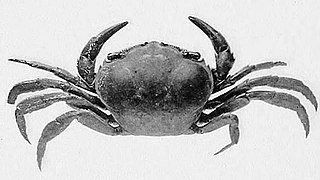
Deckenia is a genus of freshwater crabs from East Africa, in the family Potamonautidae, or sometimes in a family of its own, Deckeniidae. The genus was named by Hilgendorf after Karl Klaus von der Decken who collected the first examples during his expeditions to Africa. Both species live in swamps from Eyl in Somalia to Dar es Salaam, Tanzania, both in coastal areas and further inland. A third species, Deckenia alluaudi, lives in the Seychelles, and has been transferred to a separate genus, Seychellum.
Johora singaporensis, the Singapore stream crab or Singapore freshwater crab, is a critically endangered species of freshwater crab endemic to Singapore. It grows to a size of 30 millimetres (1.2 in) wide.
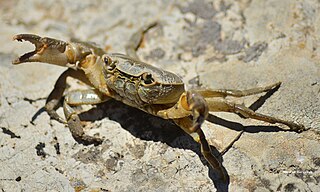
Potamon algeriense is a freshwater crab found in North Africa.

Around 1,300 species of freshwater crabs are distributed throughout the tropics and subtropics, divided among eight families. They show direct development and maternal care of a small number of offspring, in contrast to marine crabs, which release thousands of planktonic larvae. This limits the dispersal abilities of freshwater crabs, so they tend to be endemic to small areas. As a result, a large proportion are threatened with extinction.
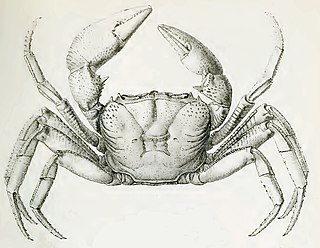
Seychellum alluaudi is a species of freshwater crab endemic to the Seychelles, and the only true freshwater crab in that country. It lives in rainforest streams on the archipelago's granitic high islands. Although it may be abundant, little is known about its biology. If its habitat were to decline in quality, S. alluaudi might become endangered, but it is currently listed as Vulnerable on the IUCN Red List.

A number of lineages of crabs are designed to live predominantly on land. Examples of terrestrial crabs are found in the families Gecarcinidae and Gecarcinucidae, as well as in selected genera from other families, such as Sesarma, although the term "land crab" is often used to mean solely the family Gecarcinidae.
Syntripsa flavichela is a species of freshwater crab found in Lake Towuti and Lake Mahalona on the Indonesian island of Sulawesi.
Migmathelphusa olivacea is a species of freshwater crab found in Lake Poso on the Indonesian island of Sulawesi. It is the only species in its genus. It is listed by the IUCN as Endangered, given "its extent of occurrence and area of occupancy is less than 500 square kilometres (190 sq mi)", and its individuals being found in less than five locations. There is also a "decline in the extent and quality of its habitat and it is not found in a protected area". Being found around a lake, "present and future threats to this species include human-induced habitat loss/degradation due to population increases and industrial and agrarian development".

Red Devil Vampire Crabs are decapod crustaceans part of Brachyura.

Geosesarma dennerle is a species of small land-living crabs found on Java, Indonesia.
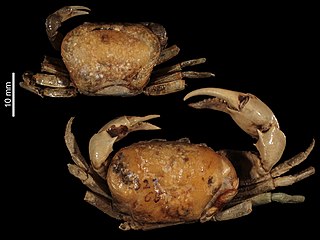
Austrothelphusa transversa(von Martens, 1868), also known as the inland crab, freshwater crab, or tropical freshwater crab is a species of freshwater crab endemic to Australia. A. transversa is the most widely-dispersed species of its genus, as it has adaptations giving it a high tolerance to drought and arid conditions.

Nanhaipotamon is a genus of freshwater crabs, in the subfamily Potamiscinae, found in southern China and Taiwan. As of 2018, 18 species have been described. The genus is named after the South China Sea, for it occurs mostly in coastal areas. The genus was first described by R. Bott in 1968 as Isolapotamon (Nanhaipotamon), i.e., a subgenus of Isolapotamon.

Nanhaipotamon macau, the Coloane hill crab, is a species of freshwater crab found solely in twelve hill streams on the island of Coloane in Macao. A member of the genus Nanhaipotamon, it was first described in December 2018 and is closely related to other land crabs such as Nanhaipotamon hongkongense.
Yuexipotamon is a monotypic genus of freshwater crabs in the subfamily Potamiscinae, found in the Heishiding Nature Reserve in Zhaoqing, south China, and first described in 2014. The only species is Yuexipotamon arcophallus. It superficially resembles Huananpotamon.
Minutomon is a monotypic genus of freshwater crabs in the subfamily Potamiscinae, found in Shanwei, south China, and first described in 2014. The only species is Minutomon shanweiense. It superficially resembles Sinopotamon.













